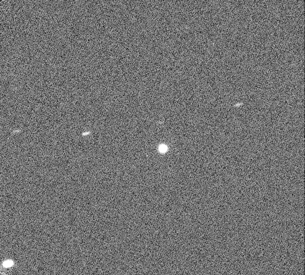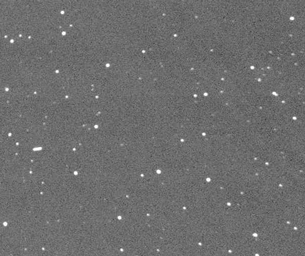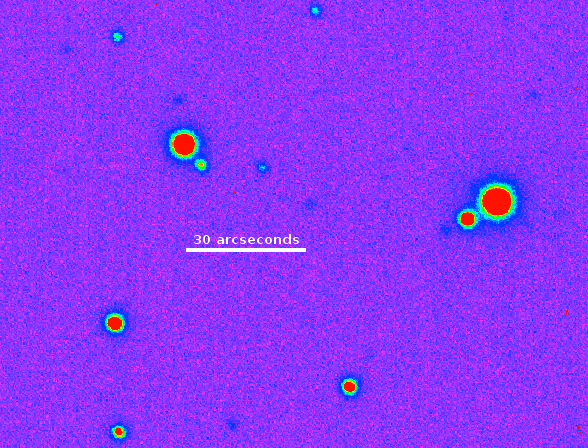The Liverpool Telescope locked on to asteroid 2012 DA14 during its "close shave" flyby on 15th February, demonstrating its ability to track "non-sidereally" on an object moving at least 5 arcsec/sec against the background stars. The same asteroid, smaller than a Boeing 747 airliner, was observed again a week later when it was more than 4,000,000 km from Earth, and as faint as a candle over 4,000 km away. Performed as part of research into asteroid tracking techniques, these tests were made using three of the LT's suite of detectors: RISE, SkyCamZ, and IO:O.
The recent close approach of asteroid 2012 DA14 was tracked by the Liverpool Telescope on 15th February. Below are image sequences of the asteroid when it was 100,000 km from the Earth. In these images the object was moving at a non-sidereal rate of 5.5 arcminutes per minute. The movie below left was constructed from fifty frames taken through the telescope's RISE camera, and is speeded up about ten times; the whole sequence takes about 100 seconds in real time.
 Sequence of RISE images showing tracking of asteroid 2012 DA14 while it was moving at 5.5 arcsec per second relative to background stars. (© 2013 Liverpool Telescope) |
 Sequence of SkycamZ images showing first sidereal then non-sidereal tracking of asteroid 2012 DA14, taken at a different rate, but at the same time as the RISE images at left. (© 2013 Liverpool Telescope) |
 Asteroid 2012 DA14 a week after closest approach, in a sequence of three false-colour IO:O frames spanning two minutes. (© 2013 Liverpool Telescope)
Asteroid 2012 DA14 a week after closest approach, in a sequence of three false-colour IO:O frames spanning two minutes. (© 2013 Liverpool Telescope)
The telescope's RISE camera was used rather than its primary IO:O imager because of the asteroid's brightness - the extreme sensitivity of IO:O was not needed for this object. Also, RISE has almost the same field of view of about 10 arcminutes.
At the same time the asteroid was also imaged using SkycamZ, the co-pointing 200mm (7.9 inch) wide-field telescope mounted on the top-end ring of the LT, which has a 1-degree field of view. This movie (above right) is made up from two initial sidereal (star-tracking) images first, which show the moving asteroid as a streak entering the frame at left. Then the next three frames are images taken when the telescope switched instantly to non-sidereal asteroid tracking mode, which suspended the asteroid's motion in the field of view and allowed the stars to trail by instead. All of these SkycamZ images are 10-second exposures made 1 minute apart.
At the time all of these sequences were made, the asteroid was moving at a topocentric (apparent to observer) angular speed of 5.5 arcseconds per second, and was 104,000 km away. However, a week later, on the morning of 23rd February, the LT observed the asteroid again using its IO:O imager (see right). By then 2012 DA14, which is slightly smaller than a Boeing 747 aeroplane, was 4 million km away (over ten times further away than the Moon), and its apparent angular speed had slowed right down to just one arcsecond per minute.
Performed as part of research into asteroid tracking techniques, these tests also demonstrate the LT's capability to track at non-sidereal rates of at least 5 arcseconds/sec (300 arcseconds/minute).


